This is a Fuji K-28, a manual focus 35mm point and shoot camera that was part of Fuji’s line up of construction cameras that came in rugged, dust and weather sealed bodies that were sold in Japan only. This class of camera was very popular at the time and are often referred to as “Genba Kontaku” cameras which translates to “site supervisor” in English. This model features one of Fuji’s better semi-wide angle lenses with full automatic exposure, an in-body electronic flash, but manual focus which was thought to be more useful in professional environments in which auto focus sensors would often struggle. Cameras like the K-28 are hard to find today, especially in good condition as many of these were used for their intended purpose, which often subjected them to some pretty tough working conditions.
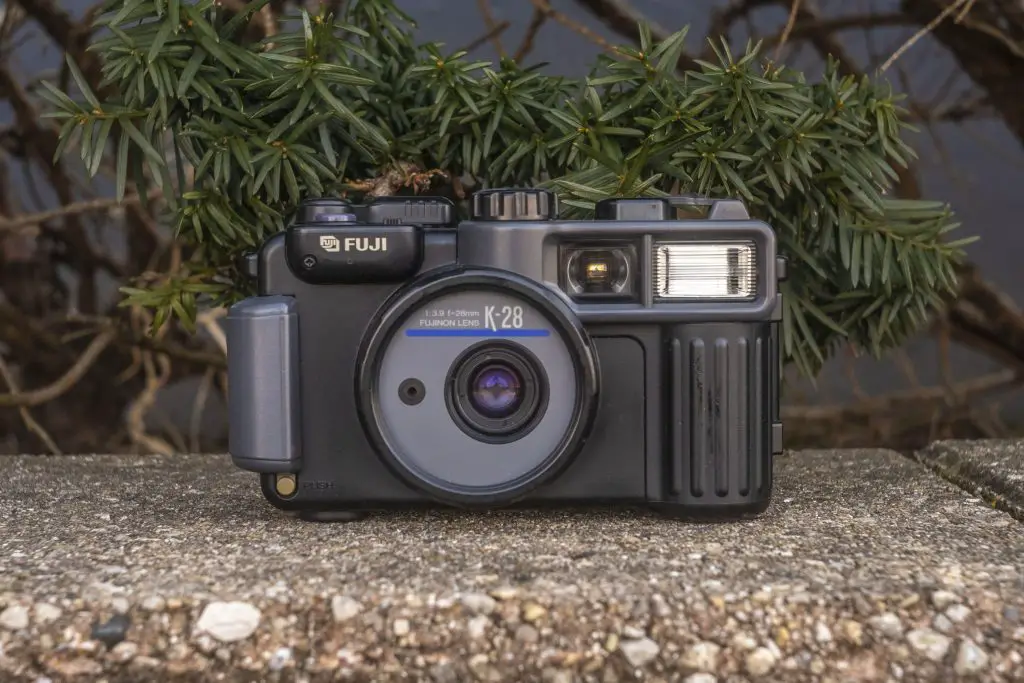 Film Type: 135 (35mm)
Film Type: 135 (35mm)
Lens: 28mm f/3.9 Fujinon coated 5-elements
Focus: 0.75 meters to Infinity
Viewfinder: Scale Focus with 28mm Projected Frame Lines
Shutter: Metal Blade
Speeds: Single Speed, 1/100
Exposure Meter: Coupled CdS Cell w/ Programmed Priority AE
Battery: (2x) 1.5v AA Alkaline
Flash Mount: In-body Electronic Flash
Weight: 424 grams
Instructions: https://totteme-camera.com/fujifilm-k-28/ (in Japanese)
How these ratings work |
The Fuji K-28 is an interesting camera with an uncommon feature set with manual focus, but fully automatic exposure operation. It has a good lens, a rugged and weather resistant body, but only a single shutter speed. When used to it’s strengths, it is a very capable and fun camera to use, but it’s physical limitations definitely limit the instances where the camera can be used. If you’re interested in trying one of these out, good luck finding them anywhere outside of Japan as that is the only country where they were marketed and when found today, are usually in very poor condition. | ||||||
| Images | Handling | Features | Viewfinder | Feel & Beauty | History | Age | |
| 1 | 2 | 1 | 1 | 1 | 1 | 0% | |
| Bonus | none | ||||||
| Final Score | 7.0 | ||||||
History
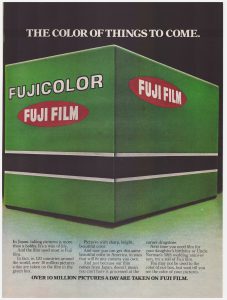
Throughout the 20th century, Fuji was one of the biggest names in the photography industry. Their film division competed against Kodak and AGFA with their Fuji lineup of color and black and white films. Fuji’s camera division produced a great number of excellent professional, semi-professional, and amateur cameras, all the way from their Fuji 6×9 medium format cameras, their Fujica lineup of rangefinders and SLRs, to their vast array of consumer level point and shoot cameras.
Yet strangely enough, Fuji’s photography division was just one of many industries that the company was known for. In the early 20th century, the company got it’s start producing celluloid for a number of different uses, from beauty products to ornate knife handles, and even cinematic film. Fuji’s product lines extended well into industrial areas too.
In 1953, the merger of five different Japanese industrial companies combined to form Fuji Heavy Industries. Products produced by the new company consisted of everything from aircraft to construction equipment to automobiles. There weren’t many different industries in the world that Fuji didn’t either directly have a hand in, or indirectly compete with.
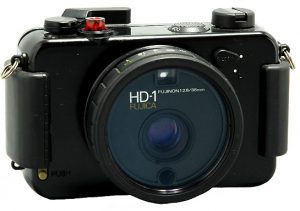
It was probably no surprise that on occasion, Fuji’s various areas of expertise would cross over, when in 1979, Fuji released a heavy duty camera called the HD-1 which came in a rugged rubber and metal body that could hold up to the tough conditions of construction work and other heavy industries.
Fuji’s line up of HD cameras was very popular throughout the 80s, as the cameras were splash and dust proof, had oversized controls that could be used while wearing gloves, and could take bumps, drops, and other types of abuse that would damage lesser cameras.
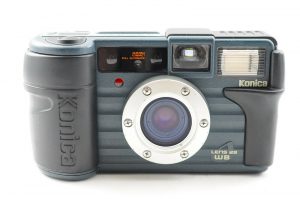
By 1988, the market for rugged cameras expanded when Konica would release the Genba Kontaku or “site supervisor” camera that mimicked the rugged design of Fuji’s HD cameras. Most of these heavy duty cameras shared a simple rubber and plastic body that was designed to be shock proof, and had weather tight film compartments, fast prime lenses, and usually lacked gimmicky features so as not to over complicate the design.
In 1991, Fuji would release a new model called the K-28. Still part of Fuji’s HD-series, the K-28 came in the usual rugged body, but with a wide angle 28mm f/3.9 lens, an in body electronic flash, and programmed auto exposure. Although resembling a typical point and shoot camera of the day, the K-28 was manual focus only, relying on a centrally located knob on the top of the camera. It was thought that a manual focus camera could better withstand the harsh conditions these cameras were subjected to, rather than sensitive electronic motors and servos.
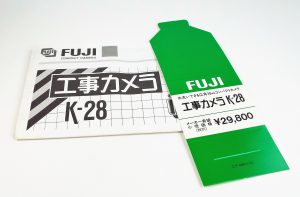
The K-28 was only sold in Japan, and sometimes referred to simply as the “Construction Camera”. Not much is known about the camera or how it was marketed, but is often found in it’s original box with a price tag of ¥29,800 which according to Chris Whelan’s article on the camera, compared to $215 then, or a little over $400 after adjusting for inflation today.
I believe the camera was in production for quite some time as in 2000, nine years after it’s release, Fuji announced a product warning about the use of certain types of batteries that could release harmful gases if left in the camera for too long.
Today, there is a small following of people who enjoy using point and shoot 35mm cameras. Models with a fixed focal lens (non-zoom) lens with a relatively large aperture are more popular than others due to their simplicity and generally good image quality. I don’t know that many people specifically seek out rugged construction cameras like this, but with it’s good lens, good build quality, and ease of operation, I have to imagine there are at least a few people out there who this camera would appeal to.
Being a Japanese only model however, finding one of these in the United States is very difficult. The few that are for sale are almost always in really rough condition as they were likely used for their intended purpose, but nice ones like this do show up from time to time.
My Thoughts
When looking for future cameras to review on this site, I often prioritize quirky cameras with features not found on many others, or cameras with a feature that might have been common on other models or from a different time. This is pretty easy to do with cameras made in the early to mid 20th century, but as you get closer to recent times, finding a 1980s SLR or a 1990s point and shoot with something unique gets a little more challenging.

The Fuji K-28 is one such camera, a point and shoot auto exposure camera from the early 90s built for the construction industry, but entirely manual focus. With the rise of the auto focus point and shoot segment in the late 70s and early 80s, manual focus compact cameras seemed to disappear almost every night. When Canon released their first Sure Shot in 1979, their era of manual focus rangefinders was over. The same thing happened at Minolta, Konica, Yashica, and pretty much every other company. As soon as automatic focus became a viable technology, manual focus cameras, first with point and shoots but later with SLRs, seemed to disappear over night. The fact that a manual focus plastic camera from 1991 exists at all seemed worthy of my interest.
This Fuji K-28 came to me via Roger Beal who included it in a box of other cameras he thought I would find interesting. I had seen K-28s on eBay before, but always from Japanese sellers, and always in very heavily worn condition.
This K-28 was in pristine condition, looking like it had rarely been used before, and if it had, certainly not on a construction site like it was intended. The camera is a bit larger and heavier than a typical all plastic point and shoot. The extra “chunk” of course was there to protect the camera from drops and other bangs that a rugged camera should be capable of.
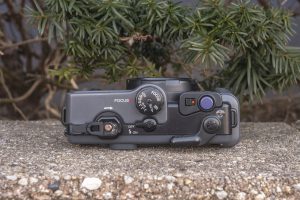
Designed to be handled with gloves, everything about the K-28 is just a little bigger. From left to right is the fold out rewind crank which tucks in neatly into the top plate when not in use. In the middle is the large focus wheel which has distances indicated in meters only. Behind it is the on/off switch for the flash only, as the camera automatically powers on the metering circuit with a half press of the bluish-purple shutter release.

To the left of the shutter release is a shutter lock which sort of resembles a power switch, but to the best of my knowledge doesn’t actually turn the meter on. Finally, there is the large film advance lever, comfortably located in it’s usual position. Oh yeah, I almost forgot about the automatic resetting exposure counter.
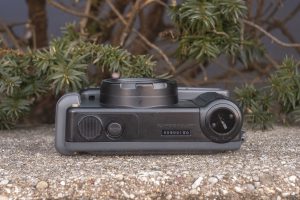
On the camera’s bottom, from left to right is a large plastic circle that serves no other purpose other than to act as a “foot” to balance out the camera when sitting on a flat surface and then a rubberized cover over the rewind release button. When it’s time to rewind the film, pressing this button requires a good deal of force before you’ll hear a small click as the film transport is disengaged, but once that happens, you do not need to keep holding the button down. The camera remains in rewind mode until the next time you wind the film advance lever. Finally, on the right is the battery compartment which despite looks like a button cell film compartment, holds two AA batteries.
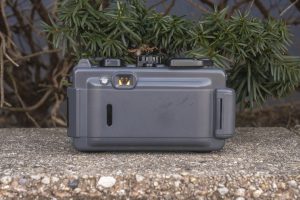
The back of the camera is mostly just gray plastic, interrupted by various swoops and curves with only the rectangular eye piece, flash ready indicator light, and a clear film type peephole for seeing what kind of film is loaded into the camera.

In order to maintain a splash and dust proof seal in the film compartment, the camera has a very robust latch on it’s side which also doubles as a small handgrip, that grips the door tightly to keep it shut. In order to release this latch, you must first press an unlock button in the bottom left corner of the front of the camera. Doing this allows you to pull out on the hand grip, which releases the latch, allowing you to open the film compartment.

Other than a left hinged door, the film compartment is pretty typical. Film transport is from left to right onto a fixed and double slotted take up spool. Although not technically a quick load feature like found on many other cameras of the day, both sides of the spool have a yellow slot with a large “tooth” for gripping a perforation on the 35mm film, making film loading a snap. Simply inside the leader inside of the rectangle and wind the camera and it will quickly attach itself to the leader.
Around the perimeter of the door is a thick rubber gasket, which on this example was still in very good condition and looks as though it could survive another couple decades before needing to be replaced. The only place where foam is used is around the small film type peep hole.

Having a completely automatic exposure system with only a single shutter speed, the only real control on the camera is the manual focus knob on the camera’s top plate. This location is quite odd, but I guess was necessary in order to make the entire front of the camera completely sealed from the elements. Looking at the Nikonos II underwater camera, that model also controls focus with a knob in a strange location, but unlike the Nikonos in which the left hand can easily rotate the focus knob, the K-28’s location on the top is a bit awkward.
Thankfully, the wide angle 28mm lens offers large amounts of depth of field which means focusing this camera for anything but closeups really isn’t all that critical. I could not find any scans of the camera’s manual, but just going off an online depth of field calculator for a 28mm lens, with the camera set to 3 meters, in average lighting at f/8, everything from about 1.5 to 33 meters should be in focus. This being a camera intended for use in construction zones, it was likely shot a majority of the time outdoors, and with the in body flash, likely could compensate for anything 5 meters and closer. I doubt this being a manual focus camera was seen as much of a con by it’s target customer base.

The viewfinder isn’t huge but big enough that I could see the entire image while wearing prescription glasses. I have to imagine this being a camera used on work sites, there’s a much higher chance of people using it wearing protective goggles or glasses, so my experience with prescription glasses is likely more typical of it’s use than for a normal camera.
Everything about the viewfinder is typical of a 90s point and shoot with nothing more than projected frame lines with parallax marks and a LED readiness indicator visible. Otherwise, there’s not much else to see.
The Fuji K-28 is intended to be easy to use, so with a quick glance at the controls, the next thing to do is to load in some film and take it out shooting.
My Results
For the first roll through the Fuji K-28, I chose some fresh Fuji 200 film and used it to shoot pictures of some random road construction around my house! I figured that if I am going to review a camera built for use at work sites, I should probably shoot some work sites!
I didn’t know what to expect when I was shooting the K-28. On one hand, I have consistently gotten excellent results from other Fuji cameras like the Fujica 35-ML rangefinder, the half frame Fujica Drive, and I’ve read positive things about Fuji’s 1970s SLRs, but on the other hand, this is a single speed point and shoot camera created for a very specific purpose, so how good could the results really be?
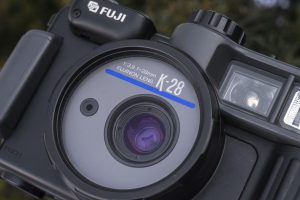
Turns out that the answer to that question is excellent! The 5-element Fujinon lens produced images as good as any I’ve seen from any point and shoot camera of the era. Sharpness is excellent across the entire frame with only the minimum amount of softness near the corners. Colors were faithfully reproduced using Fuji 200 film, and contrast was as good as any modern coated lens camera.
A 28mm wide angle focal length meant that composing images was really easy as not only could I fit a lot into the image, but also depth of field was very wide. I’ll admit to not trying any difficult shots with the camera, mostly shooting road construction equipment probably 10-50 feet in front of me. I felt this was consistent in how this camera would have been used, as “site supervisors” likely would have never cared about bokeh or creative close focus shots.
Compared to other point and shoots of the era, the K-28 is fairly large as the extra plastic “armor” adds to it’s bulk, but in my opinion, it works in the camera’s favor. Whatever you lose in pocketability, you gain in comfort. The right handed grip added somewhat of an SLR feel to an otherwise point and shoot camera, and the small grip on the other side the camera added a bit of ambidexterity for those who are left handed.
The Fuji K-28 is an interesting camera with manual focus but completely automatic exposure. The single shutter speed certainly limits your use of the camera, but that’s not exactly unusual for many point and shoots of the era that were calibrated only for ISO 100 and 400 speed films. My choice of 200 speed film was well within it’s capabilities. Had I loaded in black and white film, latitude would have likely allowed me to shoot an even wider speed of films.
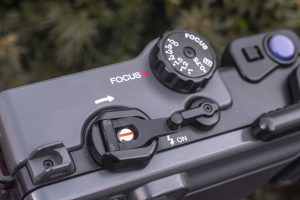
The added manual control over focus is actually helpful as you never have to worry about “fighting” with the simple auto focus systems found on nearly every other point and shoot camera. I don’t care how advanced an auto focus system claims to be, I don’t think I have ever shot a fully automatic camera and had 100% of my shots come out properly in focus. A combination of the unreliability of early AF systems, combined with no ability to see what the camera has detected means you’ll never really know what you got until after your film comes back. With the K-28, this isn’t a problem, assuming you know how to zone focus.
The fact that this was a Japanese market camera, and no other model with a similar feature set was exported to the United States suggests that people preferred the simplicity and unpredictability of auto focus however, which is a shame, as I think a similar camera with manual focus plus more control over exposure and more than one shutter speed would have been really interesting.
This is a camera that you are not likely to find often in the US, and even if you plan on importing one, finding one in good condition will be difficult as many of these cameras saw a great deal of rugged use, but if you are in the mood for a simple point and shoot manual focus camera, there aren’t a lot of options, making the K-28 an easy recommend from me.
Related Posts You Might Enjoy
External Links
http://camera-wiki.org/wiki/Fuji_K-28
https://www.imagingpixel.com/p/fuji-k28.html
https://yashicasailorboy.com/2017/05/23/fun-with-fujis-k-28-construction-camera/
https://ameblo.jp/take4-38/entry-12293752483.html (in Japanese)
https://totteme-camera.com/fujifilm-k-28/ (in Japanese)

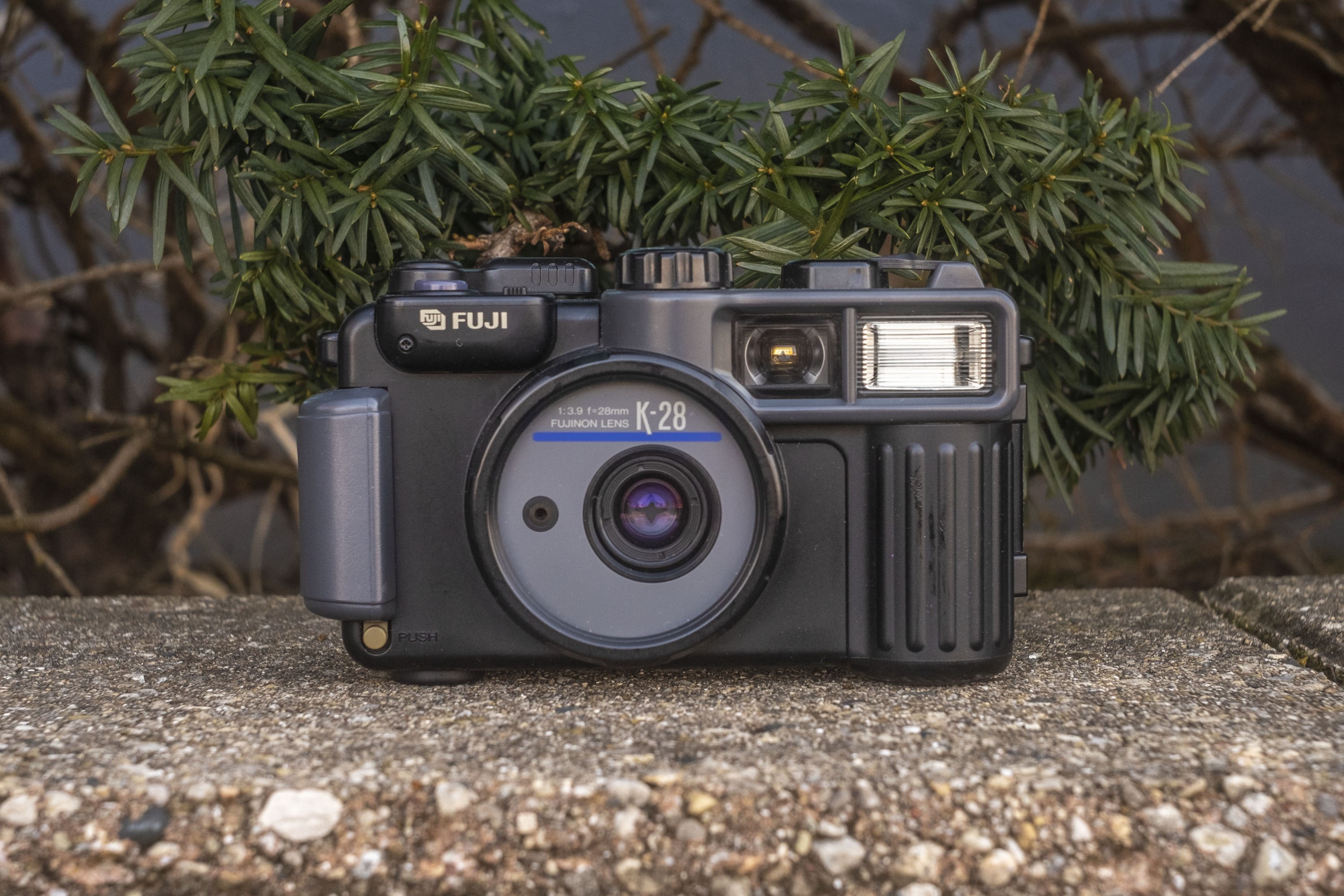
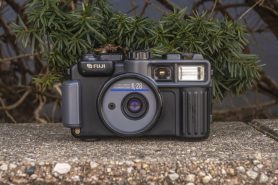















Mike, it doesn’t pull any punches when it comes to IQ. For its intended use looks like a winner.
I was surprised too. Not just at the sharpness as I’ve gotten excellent results from other Fujinon lenses, but at how well everything was exposed. Although the camera only has settings for 100 and 400 speed film, the Fuji 200 was a perfect match for it.
You picked the right subjects for your test photos … if you’d worn a hard hat and an orange vest, the guys on that road job might have thought you were their new supervisor! Manual focus was why I bought this camera, after scrapping out who knows how many decent p&s cameras due to AF motor failure.
Yeah, I couldn’t find my orange vest, but did have on my Native American uniform though. The police officer directing traffic really appreciated it!